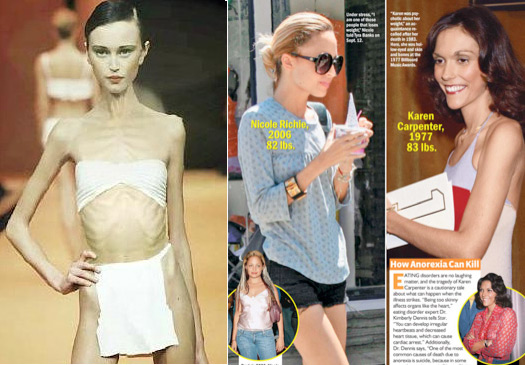
From Thin by Lauren Greenfield
In high school, I knew a girl who was so thin and so popular that I stopped eating. At 16, I thought that if I looked like her, I’d have more friends. My weight quickly plummeted down to 80 pounds: I looked like I was dying and I probably was. Soon, I found myself in a kind of disciplinary lockdown, eating meals under the watchful eye of our school nurse. All of which was seriously unpleasant — but eventually, I rallied.
Sadly, many do not. The mortality rate associated with anorexia nervosa is twelve times higher than the death rate of ALL causes of death for women between the ages of 12 and 35, giving it the highest mortality rate of any mental illness.
In high school, I knew a girl who was so thin and so popular that I stopped eating. At 16, I thought that if I looked like her, I’d have more friends. My weight quickly plummeted down to 80 pounds: I looked like I was dying and I probably was. Soon, I found myself in a kind of disciplinary lockdown, eating meals under the watchful eye of our school nurse. All of which was seriously unpleasant — but eventually, I rallied.
Sadly, many do not. The mortality rate associated with anorexia nervosa is twelve times higher than the death rate of ALL causes of death for women between the ages of 12 and 35, giving it the highest mortality rate of any mental illness.
To the degree that body image lies at the core of this pathology, how can visual people not take notice?
We do take notice, but not necessarily in a way that boosts awareness or deploys design thinking to find new and creative ways of approaching this tricky issue. (When we think of design as a catalyst for social change, this is probably not what most of us imagine.) And why not? Much of the fixation on thinness is blamed, not surprisingly, on the media, led in no small part by a veritable barrage of what some have taken to calling lollipop heads. "How, in an age that seeks to empower women's standing," asks the writer Daphne Merkin, "has the female image become honored mainly in its dimunition?"
We do take notice, but not necessarily in a way that boosts awareness or deploys design thinking to find new and creative ways of approaching this tricky issue. (When we think of design as a catalyst for social change, this is probably not what most of us imagine.) And why not? Much of the fixation on thinness is blamed, not surprisingly, on the media, led in no small part by a veritable barrage of what some have taken to calling lollipop heads. "How, in an age that seeks to empower women's standing," asks the writer Daphne Merkin, "has the female image become honored mainly in its dimunition?"
How, indeed? Twenty years ago, the average model was a size 8; today she's a size 0. The fashion industry, under attack from watchdog groups seeking a revised gold standard, are beginning to take notice, issuing statements and revising criteria that seem to suggest a healthier bottom line. But to the target audience here, it remains a tough sell. “It's easy to explain why models are so skinny,” suggests one critic, “because of their strict dietary regimen of nicotine, arugula and rock-star boyfriends.” Or as Kate Moss once said, "nothing tastes as good as skinny feels."

Ana Carolina Reston Macan, the Brazillian fashion model who died from anorexia-related complications in 2006; the ultra-slim Nicole Richie, photographed in 2006; and the American singer Karen Carpenter, who died from anorexia-related heart failure in 1983 at the age of 33
Of course, yearning to be skinny is hardly a new obsession. The phrase, “You Can’t be Too Rich or Too Thin” has been attributed to everyone from Babe Paley to the Dutchess of Windsor, and has come to be personified by a kind of ultra-slender American socialite. (Think Nan Kempner and Gloria Vanderbilt, for starters.) Yet while it’s fair to say that women bear the brunt of this fixation, it’s no longer a gendered issue. A recent story in New York magazine revealed the shifting norms in body image for men as indicated by mannequins: in 1967, a male mannequin sported a 33 inch waist, whereas this year’s standard “homme nouveau” clocks in at only 27 inches. (Odder still, the average waist size of a real American man in 2006 was 39.7 inches.) Not surprisingly, eating disorders — classically the purview of the teenage girl — are significantly on the rise for men.
But the really scary part of the real skinny lies in its mind-bending advocacy efforts. Anorexia evangelists — and yes, they’re out there — promote their cause on “pro-ana” websites offering tips on fooling your parents and your doctors and your friends. Mercifully, there are also resources by and for parents as well as several well-established residential programs for treatment. The good news is, there is more transparency — more statistics to terrify and specialists to treat — than there used to be. The bad news is, anorexia persists because self-image is desperately personal, deeply psychological and, let’s face it, just wickedly hard to change. Which doesn’t mean we should stop trying.
But the really scary part of the real skinny lies in its mind-bending advocacy efforts. Anorexia evangelists — and yes, they’re out there — promote their cause on “pro-ana” websites offering tips on fooling your parents and your doctors and your friends. Mercifully, there are also resources by and for parents as well as several well-established residential programs for treatment. The good news is, there is more transparency — more statistics to terrify and specialists to treat — than there used to be. The bad news is, anorexia persists because self-image is desperately personal, deeply psychological and, let’s face it, just wickedly hard to change. Which doesn’t mean we should stop trying.
On the contrary: we should try harder.
Several years ago, the American photographer Lauren Greenfield published a book and shot a documentary for HBO that profiled four extreme cases of self-starvation. It was a brilliant, and in many ways a daring move: brutal, honest, unflinchingly bare in its depiction of what really goes on in the minds and the lives of those who suffer with eating disorders. But it’s not enough. As we continue to debate the degree to which the media reinforces the misguided idea that skeletal is beautiful, consider that — based on theoretical body fat percentages — if today's mannequins were actual human women, they would probably cease to menstruate. Consider that African American girls are 50% more likely to be bulimic than girls who are white. Consider the fact that one-fifth of those suffering from anorexia will, if untreated, die from complications related to their eating disorder, and ask yourself: is less really ever more?
Several years ago, the American photographer Lauren Greenfield published a book and shot a documentary for HBO that profiled four extreme cases of self-starvation. It was a brilliant, and in many ways a daring move: brutal, honest, unflinchingly bare in its depiction of what really goes on in the minds and the lives of those who suffer with eating disorders. But it’s not enough. As we continue to debate the degree to which the media reinforces the misguided idea that skeletal is beautiful, consider that — based on theoretical body fat percentages — if today's mannequins were actual human women, they would probably cease to menstruate. Consider that African American girls are 50% more likely to be bulimic than girls who are white. Consider the fact that one-fifth of those suffering from anorexia will, if untreated, die from complications related to their eating disorder, and ask yourself: is less really ever more?
This is the first of two essays on the visual nature of body image. The second one can be found here.


Comments [12]
09.07.10
10:23
At this link is an interesting piece of research that investigates how the brain operates and may contribute to body dismorphia. It is an elegant experiment using the perception of our own hands:
http://www.sciencedaily.com/releases/2010/06/100614160201.htm
09.07.10
11:10
"One priority was to create underwear that was not only sustainable but also stylish (thongs for women and snug trunks for men) . . ."
Really?!?!
09.07.10
01:12
09.07.10
05:34
09.07.10
10:01
09.08.10
07:33
That image reminds me of a photo series by Ivonne Thein which takes on the pro anorexia trend. I first saw some of these in Adbusters Magazine. Have you seen them? (They are digitally manipulated.)
http://www.ivonnethein.com/en/art1_1.html
09.08.10
08:37
Part of my motivation for commenting is to mention to people who have shown an interest in the topic that I'm about to release a book on the topic, "Fat Boy Thin Man." Those with the inclination can check out fatboythinman.com.
09.08.10
08:50
09.08.10
04:18
09.12.10
08:41
09.25.10
07:55
11.12.10
03:33